
Poplar - Populus: planting, growing and caring for your young plants
Contents
Poplars in a nutshell
- Poplars are large trees with a pyramidal or columnar habit that grow quickly
- Poplars are cultivated in large gardens, within poplar groves or as avenue trees
- These trees love sun and fresh to moist soil, but can adapt to drier ground
- The running roots of poplars can damage ducts or foundations
- There are around thirty species and numerous hybrids and cultivars
Our expert's word
Poplars are generally giants to be planted only in very large gardens, parks or as avenue trees along roads or ducts. They are also trees cultivated for their soft wood, used for making paper pulp, matches, crates, cheese boxes, plywood… France is, moreover, one of the world’s leading producers of poplar wood.
But poplars or Populus are also planted for their qualities as windbreaks, privacy screens and ornamental features. The tree itself has a handsome habit, often pyramidal and sometimes columnar (as with Populus nigra var. italica). The foliage, silver-backed, often turns golden in autumn and trembles at the slightest breeze. Add to this their high resistance to diseases, pests and atmospheric pollution.
Poplars should be planted in full sun in rich, moist to wet soil. These are fast-growing trees but relatively short-lived (averaging 60 years).
The roots of poplars, relatively shallow but terribly running, can damage pipes or lift paving or tarmac. Be sure to keep at least 30m (or more) between buildings and a poplar planting!
Botany and description
Botanical data
- Latin name Populus sp.
- Family Salicaceae
- Common name Poplar
- Flowering February to April (depending on species)
- Height up to 40 m
- Exposure full sun
- Soil type rich, well-drained
- Hardiness very hardy
Poplars belong to the Salicaceae family, along with willows. The genus Populus comprises 35 species distributed across the northern hemisphere. In addition to the species, humans have created numerous hybrids and cultivars. Contrary to popular belief, the genus name Populus does not come from the Latin “populus” (people), but rather derives from the Greek “papalein” (to tremble), referring to the characteristic trembling of poplar foliage.
The most common poplar species include:
- Populus alba or White Poplar: this tree grows up to 25 m tall. The foliage has a whitish, downy underside. It tolerates drought, sea spray, and poor, calcareous soil;
- Populus X canescens: a hybrid between White Poplar and Aspen. It has a rounded crown and can reach 30 m in height;
- Populus deltoides or Eastern Cottonwood: native to North America, this is a tough tree, though unfortunately short-lived and prone to breaking in strong winds;
- Populus fremontii: native to North America, it tolerates drought and extreme cold well;
- Populus lasiocarpa: a very attractive poplar with foliage veined in red and light green. It grows more slowly than its relatives, reaching only about 10 m in height;
- Populus maximowiczii: an Asian species whose young, downy shoots take on a beautiful red hue;
- Populus nigra or Black Poplar: a large poplar (30 m tall or more) with dark bark. Its cultivar ‘Italica’ (synonym ‘Pyramidalis’) is very famous and widely planted;
- Populus tremula or Aspen: a medium-sized poplar (15 m tall), vigorous and highly suckering. Its slender, flattened petioles cause the foliage to “tremble” at the slightest breeze;
- Populus tremoloides or Quaking Aspen: a North American poplar with finely dentate foliage that also trembles in the slightest breeze;
- Populus trichorpa or Balsam Poplar: native to the western United States, it tolerates sea spray well. It is characterised by strongly fragrant young wood;
- Populus yunnanensis or Yunnan Poplar: native to Yunnan, this is a very beautiful poplar with reddish-veined foliage. It also withstands heat and drought well.

Populus alba – Populus nigra – Populus tremulus

Populus alba – Populus nigra – Populus canescens
The cultivation of poplars is called poplar farming, and foresters managing poplar plantations are poplar growers. A poplar plantation is called a poplar grove.
Poplars grow very quickly. These trees have therefore been widely planted along roads, canals, or as windbreaks. Poplars do not live very long: an average of 60 years. However, the Black Poplar (Populus nigra) can live for several hundred years. The rapid growth of poplars can sometimes be a drawback: the wood is soft and breaks easily in the wind. Never stand near a poplar during a storm! (In fact, avoid trees altogether when it’s very windy!).
The root system of poplars is extensive, relatively shallow, but very running (like willows). It is therefore best to plant them far away (at least 30 m) from any buildings or structures, to avoid damage to pipes or foundations. Because the root system is shallow relative to the tree’s height, polars topple easily during storms. Two good reasons not to plant poplars near homes.
Poplars are large trees, sometimes over 30 m tall. Their habit can be columnar (Populus nigra var. italica) or pyramidal. The foliage is deciduous and consists of simple, alternate, cordate or triangular or ovate and acuminate leaves (ending in a point). The leaves sometimes have a silvery underside. The leaves are attached by a long, flattened petiole. This compression contributes to the trembling of the foliage. The foliage often turns bright yellow in autumn before falling.
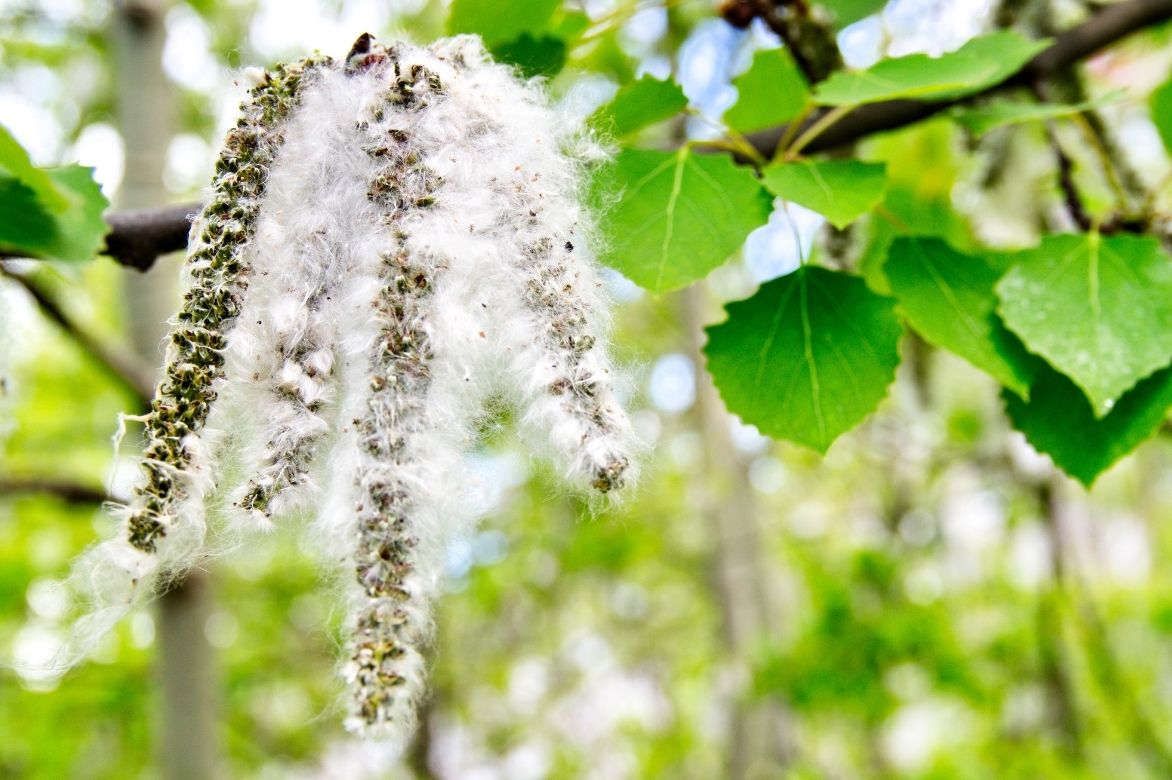
Cottony down containing seeds that will be dispersed by the wind
When young, the bark is pale, almost white sometimes, becoming darker and more fissured with age. The wood is light and used for making paper, matches, crates, plywood…
Like willows, polars are dioecious species. This means there are distinct male and female individuals. The flowers appear as pendulous catkins in spring before the leaves. The flexible male flowers have reddish stamens. Female catkins are stiffer. The pollen from the catkins can be slightly allergenic for sensitive individuals.
The fruits follow the female catkins, forming two-valved capsules containing cottony seeds. This cottony fluff allows the seeds to be carried by wind or water. The cottony down from the seed capsules can also be allergenic.
The medicinal use of poplar is very ancient. The bark was used to combat fever. The buds and leaves were known for their diuretic and anti-rheumatic properties.
Poplars tolerate atmospheric pollution very well.
Our most beautiful varieties
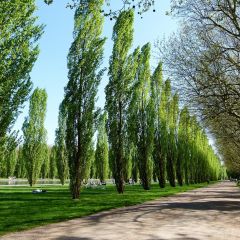
Populus nigra Italica - Black Poplar
- Flowering time April, May
- Height at maturity 30 m
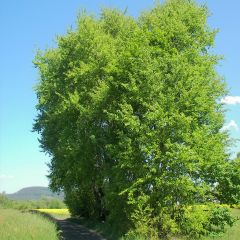
Populus tremula - Aspen
- Flowering time June
- Height at maturity 20 m

Populus alba Nivea - White Poplar
- Flowering time March, April
- Height at maturity 25 m

Populus deltoides Purple Tower - Eastern Cottonwood
- Height at maturity 20 m
Discover other Populus - Poplar
View all →Available in 1 sizes
Available in 1 sizes
Available in 1 sizes
Available in 1 sizes
Available in 1 sizes
Available in 2 sizes
Available in 1 sizes
Available in 1 sizes
Available in 1 sizes
Available in 1 sizes
Planting poplar trees
Where to plant?
The poplar is best planted in full sun.
Poplars thrive in deep, fertile soil, fairly moist to wet. The White Poplar (Populus alba) tolerates waterlogged or conversely dry soils, calcareous or poor. The Aspen withstands sea spray well and can grow in sandy, poor soil.
When to plant?
In pots: in spring or autumn.
With naked roots: between November and December.
How to plant?
- Dig a large hole: about 1 m wide and 60 cm deep;
- Loosen the bottom of the hole well and set aside the excavated soil;
- Soak the rootball if potted or slurry the roots if bare-rooted;
- Place the tree in the centre of the hole;
- Backfill the hole with the excavated soil and firm well around the base;
- Water with 10 litres of water;
- Remember to stake the tree using three stakes arranged in a triangle.
Maintenance
Remember to provide a good watering can of water from time to time when the soil dries out during the first two years of cultivation. Additionally, a good mulch at the base of the tree will help keep the soil relatively moist.
Pruning involves removing dead, diseased or poorly placed wood. Prune the branches of poplars in winter, outside frost periods and before vegetation resumes.
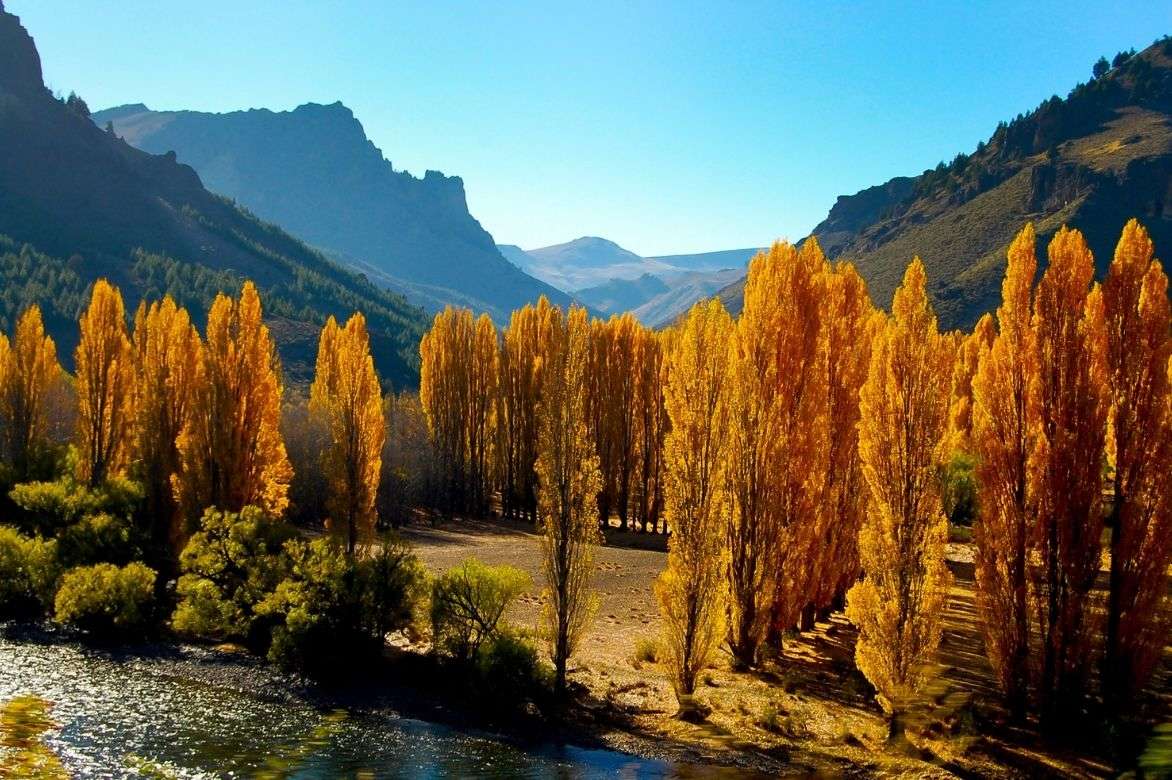
Poplars in autumn
Diseases and Pests
The new poplar cultivars are generally quite resistant to diseases, but some ailments may still occur.
Poplar Canker
Poplar canker mainly appears north of the Loire in spring or autumn. This disease is caused by a fungus, Xanthomonas populi. It thrives in warm, humid conditions. The disease first manifests as whitish, then brownish, sticky oozing at the base of buds or lenticels. Cankerous lesions, forming irregular calluses, later appear on branches.
There are no treatments available. However, you can opt for cultivars known to be resistant to the disease. It’s also advisable to prune only in winter and with tools thoroughly disinfected with alcohol.
Rust
Leaves are affected in spring when the weather is warm and humid: they discolour, then dry out and fall. The tree won’t die but will be weakened until new foliage appears.
→ To learn more about rust and how to get rid of it, follow Pascal’s advice.
Honey Fungus (Armillaria mellea)
Honey fungus is a mushroom that attacks weakened poplars. When symptoms become visible, it signals the tree’s relatively rapid decline.
→ Read our guide on Honey Fungus or root rot to learn more.
The Poplar Admiral Caterpillar (Limenitis populis)
This magnificent butterfly was once considered a pest in poplar plantations. The caterpillar feeds on the foliage of the Aspen poplar and other poplar species. However, this butterfly is in sharp decline and has practically disappeared in France and Belgium.
Propagation
The poplar naturally produces suckers from its running roots. It also self-seeds thanks to its multitude of seeds dispersed by the wind.
But the simplest way to propagate poplars remains propagation by cuttings using hardwood cuttings.
- In November-December, take 30 cm cuttings from the tips of branches (or sections of stems);
- Plant them directly in the ground (the simplest method), or in a nursery bed (moist sand) over winter while the cuttings develop roots;
- For those raised in a nursery bed, transplant the cuttings into pots with compost in spring;
- Transplant them into open ground in autumn.
Poplar propagates so easily by cuttings that poplar growers routinely plant poplar cuttings, i.e. large stems of 1.50 m-2 m about 20 to 30 mm in diameter. The lower end is trimmed at an angle and the cuttings are inserted 80 cm into the soil, at a rate of 200 young plants per hectare. A few years later, the poplar plantation takes shape.
Association
It’s challenging to suggest companion planting ideas for such large trees as poplars. Typically, poplars are planted in rows using the same essential oil.
However, let’s take the example of Populus deltoides ‘Purple Tower’ which could be coppiced annually. Its scarlet-red foliage tinged with purple will pair perfectly with other bushes and perennials featuring similarly toned leaves. Among bushes, a Physocarpus ‘Lady in Red’ along with a Berberis thunbergii ‘Bagatelle’ would work well. For perennials: some Heuchera ‘Forever Red’ will benefit from the beneficial shade provided by the bushes and the poplar.
Too red-purple for your taste? Very well! In that case, opt for a strong green-yellow contrast to highlight the foliage of the poplar and other plants. For this role, Catalpa bignonioides ‘Aurea’ would be perfect with its large green-yellow leaves. The substantial size of its leaves will complement the foliage of the ‘Purple Tower’ poplar beautifully. You can coppice the Catalpa annually too.
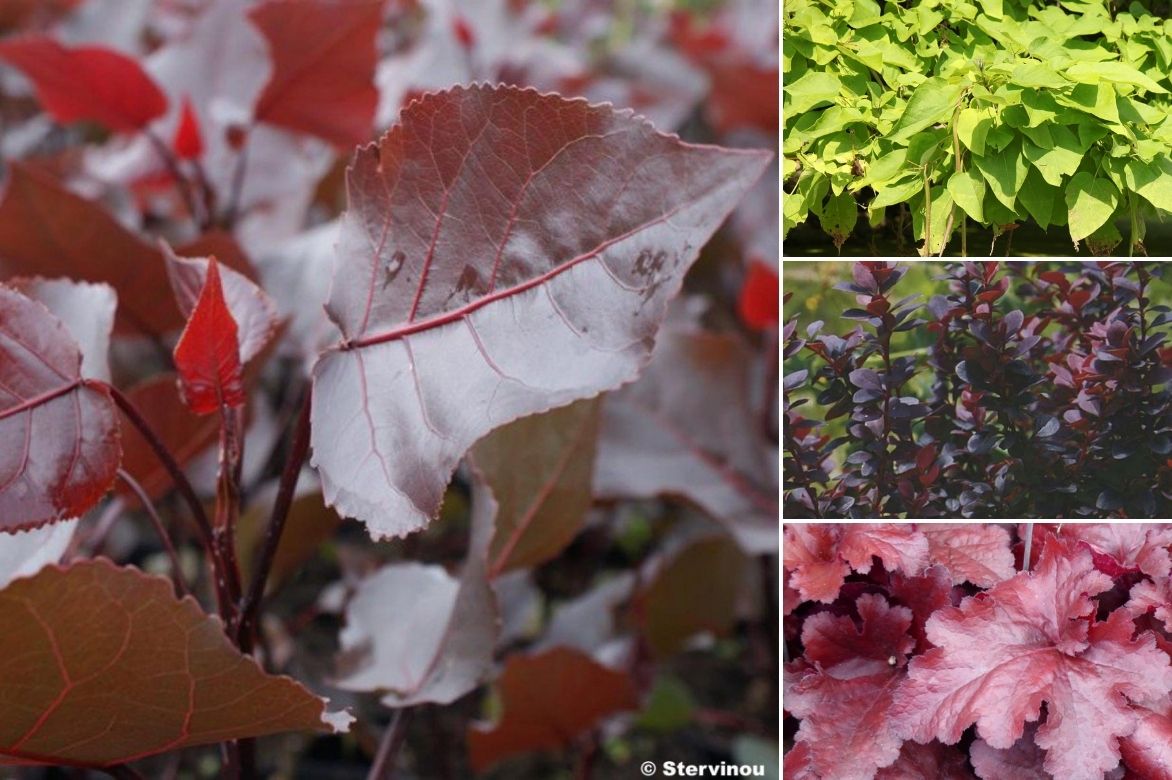
Populus deltoides ‘Purple Tower’, Catalpa bignonioides ‘Aurea’, Berberis ‘Bagatelle’, Heuchera ‘Forever Red’
Anecdotes
- France is the leading exporter of poplar wood and ranks second worldwide;
- It was Emperor Napoleon I who is said to have introduced the Lombardy Poplar to France, as a roadside or canal-side tree;
- For the druids, the poplar symbolised old age due to the silvery underside of its leaves;
- Ancient literature (Greek and Roman) regularly mentions poplars.
Useful resources
- Our finest Poplar varieties
Frequently asked questions
-
Can you plant a poplar tree if you have a small garden?
Poplars are large trees. Therefore, it's best to avoid planting poplars in a small garden. Moreover, the roots are running and can cause problems for ducts and foundations up to several tens of metres from the tree. So be cautious! Note that some cultivars, such as Populus deltoides 'Purple Tower', can be cut back to the vine-plant each spring: this allows you to keep the tree at 2m tall and obtain even larger leaves.
-
Are poplar trees allergenic?
Yes. Even though poplar pollen is considered relatively low in allergens, some people are more sensitive to it than others. The flowering period is spreading, depending on the climate, from March to May.
- Subscribe!
- Contents


































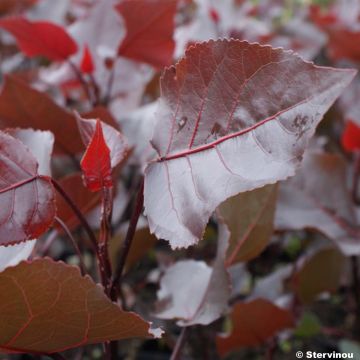
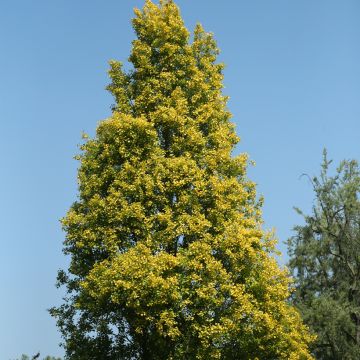

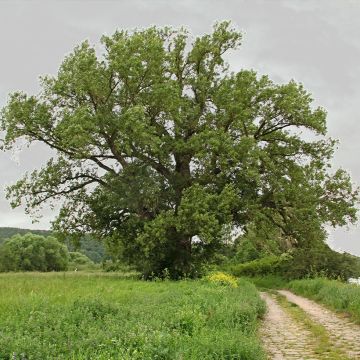
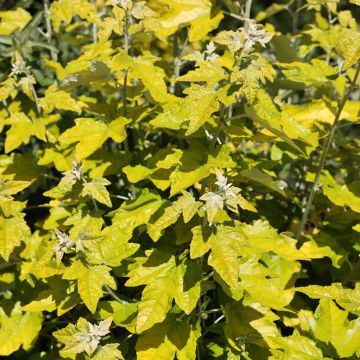
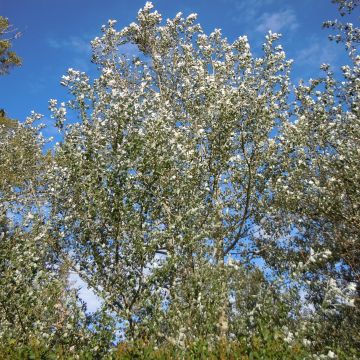
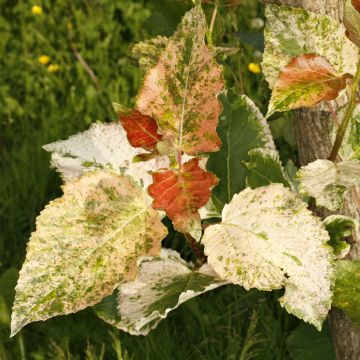
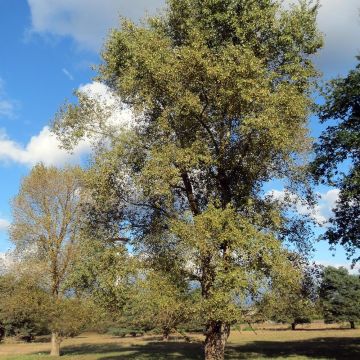
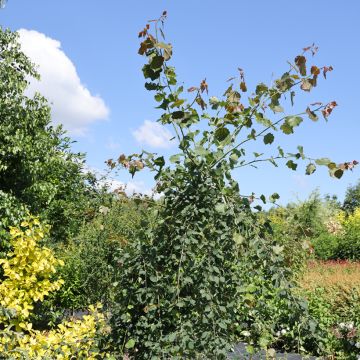
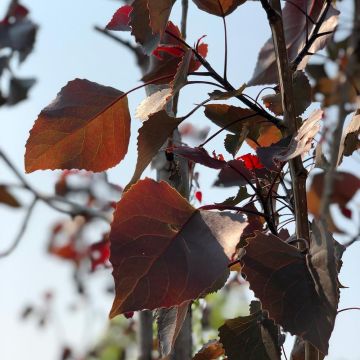
Comments